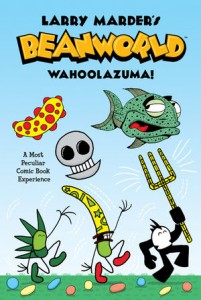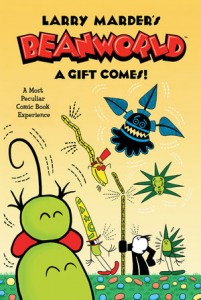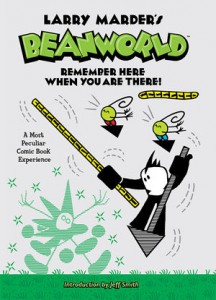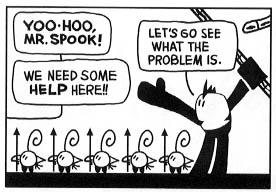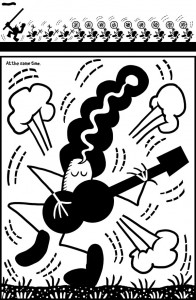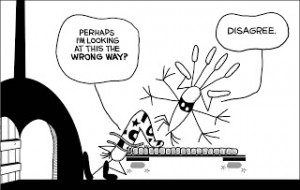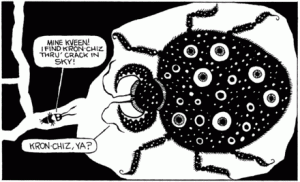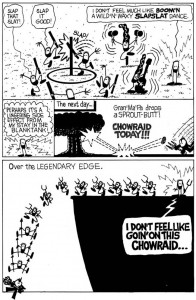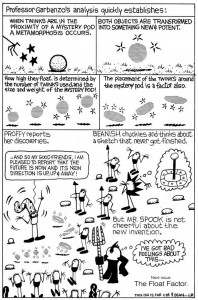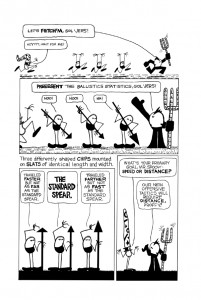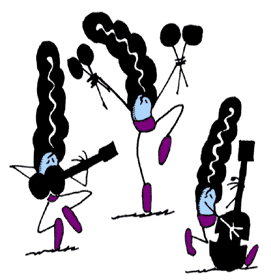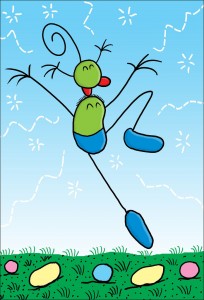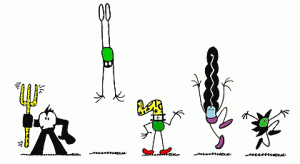Welcome to Using Graphic Novels in Education, an ongoing feature from CBLDF that is designed to allay confusion around the content of graphic novels and to help parents and teachers raise readers. In this column, we examine graphic novels, including those that have been targeted by censors, and provide teaching and discussion suggestions for the use of such books in classrooms.
This post takes a closer look at the Beanworld series by Larry Marder.
“Beanworld is a weird fantasy dimension operating under its own rules and laws. Beanworld is all about the affinity of life. All the characters, whether they are friends or adversaries, understand that ultimately they depend on each other for survival… It’s not just a place, it’s a process. It is what it is — and th-that’s all folks.’” –Larry Marder, Beanworld
“Beanworld is an all-too-rare experience in comics, or in any medium for that matter — a truly collaborative effort between creator and audience. Stored in Larry’s deceptively simple artwork is a treasure chest of ideas and emotion, waiting to be unlocked by the reader. Our experiences and perceptions are the key that unlocks that chest. But each of us has a different key and each key works in a different way, leading us to a different treasure… It reminded me of the joy of learning a new language, and how that joy had eluded me lately… I can’t tell you what you’ll discover… But I guarantee that whatever you find, it’ll be worth the search. –Scott McCloud Introduction to Beanworld Boston, MA Spring 1989
Larry Marder gives you everything you’re going to need to navigate through Beanworld in the first few pages. He introduces you to the characters in, under, around, and traveling throughBeanworld. It is a wonderful story about the forces and cycles of life, about responsibilities, about learning, and about growing. It’s about friendships and love. It’s about rivalries, creativity and balance. From Marder’s use of language, wordplay, slang and puns to his play on cultures and life and his simply drawn but far from simple images, it’s pure fun.
Table of Contents
- BACKGROUND AND OVERVIEW
- SERIES SUMMARY
- TEACHING/DISCUSSION SUGGESTIONS:
- COMMON CORE STATE STANDARDS (CCSS)
- ADDITIONAL RESOURCES
BACKGROUND AND OVERVIEW
The first issue of Beanworld was published in 1985, and the series ran 21 issues until 1993. The first four issues were printed independently under the Beanworld Press imprint. Starting with issue #5, the title was released by Eclipse Comics. A total of four book collections were released, reprinting issues #1–16.
The series was revived in February 2009 and is now published by Dark Horse Comics in deluxe hardcover editions. Wahoolazuma (February 2009) reprinted the first nine issues. A Gift Comes! came out in July 2009, and a new one-shot comic came out in December 2008. A third hardcover volume, Remember Here When You Are There! came out in November 2009, with all new material. Marder says that this completes the Springtime cycle of Beanworld stories. Further volumes are planned.
Marder notes that his work has been strongly influenced by Marcel Duchamp and this is obvious on many levels. This in itself is worthy of lessons integrating art, history, and the art and magic of storytelling.
The MOMA (Museum of Modern Art, NYC), which exhibits several Duchamp pieces, introduces Duchamp with the following excerpt:
French painter, sculptor and writer. The art and ideas of Duchamp, perhaps more than those of any other 20th-century artist, have served to exemplify the range of possibilities inherent in a more conceptual approach to the art-making process. Not only is his work of historical importance — from his early experiments with Cubism to his association with Dada and Surrealism — but his conception of the ready-made decisively altered our understanding of what constitutes an object of art. Duchamp refused to accept the standards and practices of an established art system, conventions that were considered essential to attain fame and financial success: he refused to repeat himself, to develop a recognizable style or to show his work regularly. It is the more theoretical aspects implicit to both his art and life that have had the most profound impact on artists later in the century, allowing us to identify Duchamp as one of the most influential artists of the modern era. (Oxford University Press, 2009)
Looking at readers’ comments on Beanworld and looking at Marder’s art, the influence is clear. Like Duchamp, Marder creates his own standards of comic book/graphic novel art and style. Beanworld is truly unlike any other comic or graphic novel you will pick up, and Marder creates a world that each and every viewer will “see” differently.
From the chapter “Larry Marder Building Bridges” in Comic Book Rebels: Conversations with the Creators of the New Comics (edited by Stanley Wiaterand and Stephen Bissette; Donald I. Fine, Inc., 1993):
Beanworld is the exact opposite of most modern comics. The artwork is really simple and the storyline’s quite complex. Most comics have complicated artwork supporting very simple storylines… Obviously Beanworld works on two levels… like Rocky and Bullwinkle the sense that there are many levels of complexity the reader can draw from the story, but the surface level is accessible enough for children to enjoy it, which is something that took me completely by surprise.
Larry Marder’s Beanworld looks at life with an unusual lens that allows us to reflect as well as laugh at its perplexities, its challenges, and all its wonderful quirks. Presented to us (originally) in black and white drawings that look two-dimensional and simplistic, they are anything but simple. These packed panels offer readers a refreshing look at life, while the playful language and illustrations teach us all about balance — balancing the fun, balancing the love, balancing individuality and community, and balancing responsibilities. What life’s ultimate secret is, however, may be different for each of us, but it’s all here for us to discover! The seeming simplicity of Beanworld and its ability to reach each of its readers on different levels is what makes this so wonderfully brilliant and unusual. Readers can look at and read this from afar, through a lens, from different angles, and over and over again and not get tired of it.
The series is as playful as it is nurturing and is a wonderful addition to any school classroom and library. It is a combination of pure fun with its wonderful world play (like “Hoka-hoka Gunk’l’dun,” “Wahoolazuma,” Chowdown Time, and lots of goof-off days) and with its fabled origins embedded in a tribal mythology. While it may take some time to learn the specific language of Beanworld, the series is at once deep as it is simplistic. It is fantasy, allegory, and real life.
As the life, trials, and tribulations of Beanworld’s inhabitants unfold, we learn:
- How to balance diversity and individuality on a personal level, on a communal level, and on an ecological level;
- How to keep personal interests and passions alive while meeting the pressing responsibilities that come living in a self-sustaining community;
- How to be creative in variety of different ways:
- How partnerships and teamwork are formed and used to the benefit of all;
- How everything in life has balances, realizing everything has a cost;
- How the healthiest communities and business deals are those where everyone receives some benefit — even when there is some form of loss involved;
- How compassion and appreciation are more effective than violence;
- How issues of parenting, conservation of resources, of diplomacy, and of supply and demand are best met openly and honestly
Note that Beanworld is a collection of independent issues of Tales of Beanworld. As such, because they were originally produced as individual comic books, each issue begins with a brief introduction to Beanworld. So while each issue is briefly repetitive, they are wonderfully engaging, welcoming, and engrossing and a great read for kids whether they’re in grade school, grad school, or beyond, with political, social, ecological, scientific, and overall life lessons for kids of all ages.
SERIES SUMMARY
Beanworld is a fantastical place where Beans, Dreamishness, Hoi-Polloi, Goofy Surgical Jerks, Goofy Service Jerks, Goofy Surveillance Jerks, Gunk’l’dunk, Non Worms, Big Fish, Gran’Ma’Pa, and many others co-exist and often depend one upon another. It is as much about ecology and conservation as it is about love, as much about the progress of interdependent societies as it as about plain and simple fun with language, life, and art. Wahoolazuma!
Beanworld: Wahoolazuma! introduces us to the life, characters, and ways of Beanworld. It begins with “The Beanworld Glossary,” a helpful tool to get the swing and feel of its culture. The next page contains the “Map of the Known Beanworld,” which helps put this small ecosystem in its proper perspective. Then, after the introduction by Scott McCloud (Understanding Comics), the story begins with “The Legend of Pop! Pop! Pop!” and the fun just keeps on coming.
In Beanworld: Wahoolazuma! we learn that Beanworld consists of an island surrounded by the Thin Lake and supported (both literally and figuratively) by the Four Realities (slats, hoops, twinks, and chips), which Professor Garbanzo has learned to fashion into useful tools. Beanworld, however, does not stop with the Four Realities. Below them is the Bone Zone, followed by the Hoi-Polloi Ring Herd, and finally, Der Stinkle. Every zone, being, and product plays an integral role in this ecosystem.
For the majority of Beans in Beanworld, their lives consist of “hunting” for Chow, which sustains them, or engaging in Goof-off Days where they can pursue their individual interests and passions. A select few, like Professor Garbanzo, Beanish, and the Boom’r Band have their respective specialized jobs and don’t participate in Chow raids.
The remaining Beans, however, are the Chow Sol’jers, led by Mr. Spook. Along who along with his Fork and a freshly-caught Sprout-Butt, this motley crew regularly jump into the Thin Lake and pass through the Four Realities to the Hoi-Poloi. There, the soldiers (with their spears designed by Professor Garbanzo and made from the Four Realities) break up the smallest Ho-Polloi Herd Ring they can find to take the Chow they’ve harvested from a previously left Sprout-Butt. The Chow Sol’jers consist of two divisions, Spear-Fling’n-Flank’rs and Chow-Pluk’rs. While spears are flung at the smallest ring to distract and ultimately breach the Hoi-Polloi ring surrounding their cherished Chow, the Chow-Pluk’rs pluck the chow from under them. However, to guarantee some form of balance and “fairness,” the Beans leave the new Sprout-Butt as payment for the ‘pluck’d’ chow.
Returning from the hunt, the Beans fill the Chowdown Pool with the newly secured chow and feast, rest, and play until Gran’Ma’Pa releases a new Sprout-Butt and the cycle begins again. It’s during their times of rest and play that Mr. Spook and the Bean community individually pursue their passions and interests, and the Beanworld culture continues to unfold and evolve. We also see that the Beans and Hoi-Polloi are not without other external challenges and threats.
Beanworld: A Gift Comes! continues the evolving Beanworld narrative with the birth of its next generation of Beans, the Pod’l’pool Cuties, while continuing the storylines begun in the earlier issues. Mr. Spook is still coming to grips with the loss of his fork (destroyed by the Goofy Service Jerks). In this second volume, we learn about Mr. Spook’s “problemed childhood” and how, with the help of Mr. Teach’m (who raised him on a cloud), Mr. Spook was mentored to be a hero. We also learn how Professor Garbanzo first discovered the Four Realities, and we continue to see the benefits of “the arts.” This book also continues to tell Beanish’s story, from his infatuation with Dreamishness to his quest for individuality and three-dimensional art.
Beanworld: Remember Here When You Are There! is described as the conclusion to Beanworld’s “Springtime Cycle.” In this third installment of the Beanworld story, the plot and its characters continue to bloom and grow. The Pod’l’pool Cuties are leaving their pool and learning the ways of Beanworld. Beanish toils over his love song to Dreamishness, and we see the long-awaited return of Heyoka (a Bean who one day simply left), and the Big Fish (who first gave Mr. Spook his fork). There are many more twink discoveries, and we learn more about the past with hints of the future.
TEACHING/DISCUSSION SUGGESTIONS:
Plot, Themes, and Values Related
- Have students look at each of the Beanworld issues and discuss what they teach us about Beanworld and beyond. Evaluate how they each contribute to the unfolding narrative.
- Discuss Marder’s description: “Beanworld is a weird fantasy dimension operating under its own rules and laws. Beanworld is all about the affinity of life.” How does this fantasy operate “under its own rules and laws” and teach “about the affinity of life”?
- Discuss the individuality of each of the Beanworld characters and how they work together (even when at odds) for the benefit of the Bean society. Discuss and evaluate their relationships and interdependence.
- Chart, discuss, and evaluate the different parables of life one might garner from these three books, and the unimposing way they’re presented.
- Discuss and evaluate the Cycle of Life in Beanworld and how it does or does not relate to your community.
- Throughout this series, while the various communities and cultures coexist, there are threats and secrets. Discuss how these secrets may threaten Beanworld. Discuss when and why it’s important to keep secrets and when and why it’s important to divulge secrets. How does one recognize those times?
- Discuss and evaluate Mr. Spook’s dependence on his Fork. Discuss how he comes to grips with its loss. Discuss what things your students come to depend upon and how they might deal with their loss.
- Evaluate the roles of art and music throughout the series. How does it compare to the role of art and music in your school/community?
- Discuss the pros and cons of Goof-Off Day.
Critical Reading and Making Inferences
- Throughout the Beanworld narrative, Marder makes references to various cultural icons, characters, and events. Search, research, and discuss these references. For example, many of the character names carry references and innuendos, and in Wahoolazuma (p. 101), the Professor says, “Alas poor twinks, we know you not.” Discuss this reference to Shakespeare, compare its use n Beanworld and in the original, and evaluate who affective it is here.
- When discussing the cycle of life on and under Beanworld, Marder notes the Beans “steal but leave payment” when collecting their Chow from the Hoi-Polloi. Discuss and evaluate the ethics and effectiveness of this method of survival for both cultures. Is it okay? Are there better ways to co-exist?
- In Wahoolazuma, to learn from the Ho-Polloi, Professor Garbanzo challenges them to a riddle. One Hoi-Polloi says, “She’s gonna ask a STUPID question ‘cuz she’s a STUPID bean!” Another asks, “How will we decide if it’s a stupid question?” and the first answers, “If it has a stupid answer, of course!” Discuss if there is such a thing as a stupid question. How does one define or identify “stupid questions”?
- Marder devotes a good part of A Gift Comes to the raising of the Cuties. Discuss and evaluate the Beans’ parenting and Cutie-raising techniques.
- Search and discuss the life lessons garnered from each of the volumes. Here are some examples:
- Wahoolazuma:
- pp. 10-12: Marder describes the strategies used by Beans and Hoi-Polloi during the Chow raids strategies — their effectiveness, their pros and cons — and brainstorm other possible alternatives.
- p. 18: Professor Garbonzo says, “Each reality is a tool waiting to be discovered,” and she invents the jobs for which the tools can be used. What novel or inventive tools might you develop from resources around you and in what ways might they be used?
- p. 64: “Sometimes the universe finds enigmatic ways to mend itself.” Discuss what this means, and brainstorm examples from your communities and world that support (or negate) this statement.
- A Gift Comes:
- p. 17: Dreamishness tells Beanish that he must keep their friendship a secret saying, “if you betray a confidence, you will never, ever see me again.” Beanish thinks, “It’s soooo frustrating to know something and not be able to share.” Discuss and debate the power, strengths, and challenges of secrets.
- pp. 164-165: We learn about the Goofy Surveillance Jerks “Hatbox” form of punishment for criminals. Evaluate the effectiveness as well as the pros and cons of the Hatbox. Compare and contrast their forms of punishment to your community’s forms of punishment (in your students’ respective homes, in your school, and in the larger communities).
- p. 265: Mr. Teach’m says, “Remember that, misters: There ain’t no such thing as somethin’ for nothin’.” Discuss what he means and then evaluate the truth to this.
- Remember Here When You are There:
- p. 70: Dreamishness tells Beanish, “It’s better to do it RIGHT than Fast.” Evaluate and discuss the pros and cons of this statement.
- p. 87: Dreamishness tells Beanish that she doesn’t want “A Love Song” rather she wants “THE Love Song.” Discuss the difference in her distinctions.
- Wahoolazuma:
- When evaluating Marder’s words of wisdom about Beanworld, you may also want to turn this into a writing exercise. Have students work individually, in pairs or in groups, to describe their own insights about the school community or their community at large.
Language, Literature, and Language Usage
- Search and discover Marder’s wonderful wordplay throughout the series. You may want to have students create their own additions to Marder’s created language.
- The language of Beanworld has its own rhythms and cadences. Search, evaluate, and discuss the cadence and how it influences and moves the storytelling.
- Have students identify puns, alliteration, invented worlds, and play on words. You may want students to work on teams to search for these gems, and then create some of their own examples.
- Discuss Marder’s use of accents and speech patterns (from Germanized English to slang and slurs).
Cultural Heritage and Cultural Diversity
- In Wahoolazuma, while Marder details the Cycle of Life of the Beans and of the Beans’ relationship with the Hoi-Polloi, Mr. Spook learns of a dormant threat to both Bean and Hoi-Polloi (p. 58) “Go away, der stupid-binz, INFESTICATION COMES! To claim der land dot vonce vas yours, INFESTICATION COMES! To eat der kroon-chis und lay der aigs, INFESTICATION COMES! Go way, der stupid-binz, INFESTICATION COMES!” Discuss the potential threat alluded to in this particular issue. Then brainstorm and discuss potential threats (political, environmental, social) in your community and in the world at large.
- Throughout the series, but particularly in A Gift Comes!, Marder discusses the roles and responsibilities of the various Beanworld residents. Chart the responsibilities of the Cuties, Mr. Spook, Beanish, Professor Garbanzo, the Boom’r Band, Gran’Ma’Pa, the Goofy Surveillance Jerks, and others. Discuss how each of these characters accepts and deals with their responsibilities. Compare them to people and characters in your world/communities. What can we learn from Beanworld that can be applied to our world regarding the acceptance and meeting of responsibilities?
- Following the warning, the narrator says, “Mr. Spook doesn’t understand the WARNING SONG. Instead, he hears an awful insect noise…TOTAL DIPLOMATIC FAILURE!” Discuss the diplomatic failure here, and compare this example to examples from your communities, from history, or from current events.
- Discuss the social structure of Beanworld, and compare it to various social/cultural structures in our world today.
Science and Technology Connections
- Discuss and evaluate the Professor’s use of scientific method as she investigates the forms, functions, and uses of the Four Realities.
- While discussing the Professor’s use of scientific method for the Four Realities have students brainstorm, invent, and experiment to come up with their own new Four Realities materials.
- Discuss and evaluate the Beanworld cycles of life.
- Discuss and evaluate the subtle and overt ecological messages throughout the narrative. What can we learn from Beanworld?
- Discuss and evaluate the low-tech culture of Beanworld versus our own modern hi-tech culture. What are the strengths and challenges of each?
- On page 64 of Wahoolazuma, Marder writes, “Sometimes the universe finds enigmatic ways to mend itself.” Evaluate and discuss this thought, and find examples that do (or do not) support this.
- In Wahoolazuma, while Marder details the Cycle of Life of the Beans and of the Beans’ relationship with the Hoi-Polloi, he also warns Mr. Spook of a dormant threat (p. 58) “Go away, der stupid-binz, INFESTICATION COMES! To claim der land dot vonce vas yours, INFESTICATION COMES! To eat der kroon-chis und lay der aigs, INFESTICATION COMES! Go way, der stupid-binz, INFESTICATION COMES!” Research and discuss the forms and effects of infestations that both hurt and harm communities.
- The dormant “Infestication” threat to the Bean and Hoi-Polloi (in the second Issue: Too Much Chow) comes from Der-Stinkle, where insects decide to get the “mountain-grown Kron-chiz…der richest kind…” from Beanworld. Meanwhile Der Kveen of these insects becomes too bulky and to “slim down fast… metamorphosis occurs.” Compare and contrast the process of metamorphosis, how it occurs here, and how it occurs in real life.
- In Wahoolazuma (p. 103), Professor Garbanzo helps an injured soldier into the chow tank to heal, thinking, “ Bottom line Booja-wooja! It’s the healing tune for Krink’ld limbs. The rhythm is irresistible… The Boom’n chow shakes, rattles & rolls the injured limb back into alignment.” Research and discuss the “how’s” and “whys” of music as physical and mental forms of therapy and health intervention.
- In Remember Here When You Are There (pp.115-116), Professor Garbanzo and the Chow Sol’jer Volunteers “figure out this new Flaotivation stuff.” Discuss the pros and cons of Mr. Spook’s advice: “Let’s not classifyit as anything, pending further gathering of facts. Professor Garbanzo adds, “Let’s now worry about float force’s classification before we fully understand its function.” Discuss how this advice fits into the scientific method.
Modes of Storytelling and Visual Literacy
In graphic novels, images are used to relay messages with and without accompanying text, adding additional dimension to the story. In Beanworld Larry Marder brilliantly weaves story and background with image, and emotions and insights through text, image, and design. Reading Beanworld together with your students allows you to analyze, discuss, and learn how Marder uses page and panels, text and images to relay complex messages. For example:
- While the images seem simplistic, they carry tremendous depth and detail. Evaluate and discuss Marder’s use of facial expressions and body language to relay information.
- Evaluate and discuss how very small differences (to hair, size, face, hats, chips, arms and legs, for example) distinguish these deceivingly simplistic Beans.
- Evaluate and discuss how Marder uses chunky shapes and patterns in his two-dimensional world that is altogether real and engaging.
- Discuss Marder’s use of balloon and font design (font shape, capital versus lower case letters and/or interspersed bold and italics letters) to help tell the story.
- Analyze how his choice of font, design, panel size and shape are all used to relay different character moods.
- Marder also plays a lot with the borders of his panels. Discuss why certain panel formats change when they change, and evaluate what this is trying to tell the reader.
- Just as Professor Garbanzo and the Cuties experiment with the Four Realities (slats, stars, circles/loops and triangles), have students create furniture, objects, graphic designs of their own with them.
Suggested Prose, Graphic Novel and Poetry Pairings
Relaying suggested paired readings is particularly challenging for Beanworld. Beanworld is, as noted, a “most peculiar comic book experience,” and as Scott McCloud notes of its thousands of readers, “all left thinking different things.” As a result, suggesting paired readings is difficult because Beanworld is appropriate for so many different readers from tweens through adulthood. That said, for greater discussion on literary style, related themes, similar characters and/or content here are some book suggestions you may want to pair and read:
- Bone by Jeff Smith — a different series of engaging characters that reflect the wisdoms and peculiarities of life’s challenges.
- Frederick by Leo Leoni — a picture book (for the younger spectrum of Beanworld readers) about life and importance of the arts.
- Watership Down by Richard Adams — a timeless classic set in England’s Downs about the courage and survival of a warren of rabbits.
- Flatland: A Romance of Many Dimensions by Edwin A Abbott — a delightfully different and equally “peculiar” reading experience of residents of two-dimensional Flatland (teens and older).
- The Giving Tree by Shel Silverstein (all readers) — about a tree (much like Gran’Ma’Pa) who gives all it can give to one particular boy.
COMMON CORE STATE STANDARDS (CCSS)
As this is truly an “all readers” series, I will be using the Common Core Anchor Standards for College and Career Readiness for Reading, Writing, and Speaking and Listening. Reading Larry Marder’s Beanworld and incorporating the teaching suggestions above promotes critical thinking and its graphic novel format provides verbal and visual story telling across subject areas while addressing multi-modal teaching. Here’s a more detailed look:
- Knowledge of Language: Apply knowledge of language to understand how language functions in different contexts, to make effective choices for meaning or style, to comprehend more fully when reading or listening.
- Vocabulary Acquisition and Use: Determine or clarify the meaning of unknown and multiple-meaning words and phrases by using context clues, analyzing meaningful word parts, and consulting general and specialized reference materials; demonstrate understanding of figurative language, word relationships, and nuances in word meaning; acquire and use accurately a range of general academic and domain-specific words and phrases sufficient for reading, writing, speaking and listening at the college and career readiness level.
- Key ideas and details: Reading closely to determine what the texts says explicitly and making logical inferences from it; citing specific textual evidence when writing or speaking to support conclusions drawn from the text; determining central ideas or themes and analyzing their development; summarizing the key supporting details and ideas; analyzing how and why individuals, events, or ideas develop and interact over the course of the text.
- Craft and structure: Interpreting words and phrases as they are used in a text, including determining technical, connotative, and figurative meanings and analyzing how specific word choices shape meaning or tone; analyzing the structure of texts, including how specific sentences, paragraphs and larger portions of the text relate to each other and the whole; Assessing how point of view or purpose shapes the content and style of a text.
- Integration of knowledge and ideas: Integrate and evaluate content presented in diverse media and formats, including visually…as well as in words; delineate and evaluate the argument and specific claims in a text, including the validity of the reasoning as well as the relevance and sufficiency of the evidence; analyze how two or more texts address similar themes or topics in order to build knowledge or to compare the approaches the authors take
- Range of reading and level of text complexity: Read and comprehend complex literary and informational texts independently and proficiently
- Comprehension and collaboration: Prepare for and participate effectively in a range of conversations and collaborations with diverse partners, building on others’ ideas and expressing their own clearly and persuasively; integrate and evaluate information presented in diverse media and formats, including visually, quantitatively and orally; evaluate a speaker’s point of view, reasoning, and use of evidence and rhetoric.
ADDITIONAL RESOURCES:
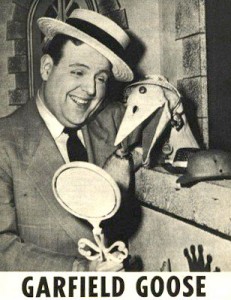 On the origins and influences of the Goofy Service Jerks and the influence of Garfield Goose, King of the United States broadcast (by creator Frazier Thomas), please visit http://larrymarder.blogspot.com/2007/08/garfield-goose-and-goofy-service-jerks.html
On the origins and influences of the Goofy Service Jerks and the influence of Garfield Goose, King of the United States broadcast (by creator Frazier Thomas), please visit http://larrymarder.blogspot.com/2007/08/garfield-goose-and-goofy-service-jerks.html- For more on the fascinating and talented Marcel Duchamp (who was also a strong influence on Beanworld) please see the Wikipedia entry at http://en.wikipedia.org/wiki/Marcel_Duchamp
- To view the Museum of Modern Art Duchamp collection please visit them at http://www.moma.org/collection/artist.php?artist_id=1634
- For more on Marcel Duchamp and his work, his life, family, and works of art: http://www.understandingduchamp.com/
- Here is a link of articles and photographs of Marcel Duchamp that can be used as a lesson in non-fiction history: http://www.marcelduchamp.net/
Meryl Jaffe, PhD teaches visual literacy and critical reading at Johns Hopkins University Center for Talented Youth OnLine Division and is the author of Raising a Reader! and Using Content-Area Graphic Texts for Learning. She used to encourage the “classics” to the exclusion comics, but with her kids’ intervention, Meryl has become an avid graphic novel fan. She now incorporates them in her work, believing that the educational process must reflect the imagination and intellectual flexibility it hopes to nurture. In this monthly feature, Meryl and CBLDF hope to empower educators and encourage an ongoing dialogue promoting kids’ right to read while utilizing the rich educational opportunities graphic novels have to offer. Please continue the dialogue with your own comments, teaching, reading, or discussion ideas at meryl.jaffe@cbldf.org and please visit Dr. Jaffe at http://www.departingthe text.blogspot.com.
Help support CBLDF’s important First Amendment work by visiting the Rewards Zone, making a donation, or becoming a member of CBLDF!
All artwork (c) Larry Marder.
